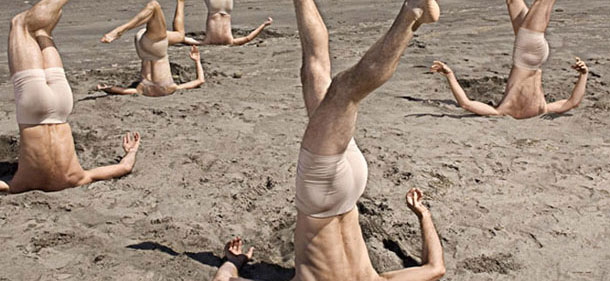
BodyVox’s “Water Bodies,” which helped inaugurate the new dance center (minus the sand!) and is going on the road. Photo: J. Dunham Carter, Polara Studios
The downside of BodyVox’s ambitious move into its own new BodyVox Dance Center in Northwest Portland?
Jamey Hampton, co-artistic director with his wife, Ashley Roland, of the Portland-based touring dance and movement ensemble, paused to consider the question.
“We were closer to cold beer before,” he finally allowed.
 Surely a heavy price to pay — and the pizza was good, too. For several years BodyVox kept house in sunny but cramped quarters on the top floor of the BridgePort Brewpub, several blocks away from the company’s new digs at Northwest 17th Avenue and Northrup Street.
Surely a heavy price to pay — and the pizza was good, too. For several years BodyVox kept house in sunny but cramped quarters on the top floor of the BridgePort Brewpub, several blocks away from the company’s new digs at Northwest 17th Avenue and Northrup Street.
But as charming as the proximity was, it’s tough to think of many other drawbacks to the move, which gives BodyVox a much bigger and more sophisticated space that also has the potential to be a vital community resource. As general manager Una Loughran put it, “We want this space to be used.”
One evening late last week BodyVox threw a little open house-slash-open rehearsal to show off the new space, and everyone was pretty much in a celebratory mood. Beer (BridgePort, of course) and wine were flying out of the lobby. Bodies were flying just as rapidly around the new stage, which is 60 feet wide as opposed to 40 in the old space, a huge difference in terms of choreographic possibility.
The rehearsal was mostly for Water Bodies, which the company is taking on tour to Philadelphia and New York state in mid-October (the home season, which will be performed entirely in the new space, opens Nov. 12), and with a crowd on hand it was loose. Christopher Stowell, artistic director of Oregon Ballet Theatre, stood at the side of the stage with a microphone to talk about what was going on in the dances, and when Hampton and Roland weren’t out on the stage performing, they joined in on the chat, too.
I talked briefly with veteran dancer Eric Skinner, one of BodyVox’s artistic anchors. He and the company were getting ready for a quick trip to Minnesota for a performance tomorrow night (Sept. 24) at College of St. Benedict and St. John’s University near St. Cloud. I congratulated him on the company’s wisdom in scheduling a trip to the upper Midwest in September instead of January.
Eric grinned. “Coldest winter I ever spent was the year I danced with Milwaukee Ballet,” he said.
By the time everything’s finished BodyVox’s main performing space will hold 160 seats, up from 90 in the old space. “It really transforms the financial picture for us,” Loughran said.
A front studio with big inviting garage-door windows onto the street was in use during the reception and already is attracting dancers for lots of classes. “That’s nice, too. Gets us back to that revenue flow,” said Loughran, whose job it is to worry about such things.
Continue reading BodyVox: Home again, home again, jiggity jig →

 So let’s play catch-up.
So let’s play catch-up. This one, however, Â was a panel discussion to introduce an audience that admittedly had more young people in it than usual to
This one, however, Â was a panel discussion to introduce an audience that admittedly had more young people in it than usual to 

 Surely a heavy price to pay — and the pizza was good, too. For several years
Surely a heavy price to pay — and the pizza was good, too. For several years 
